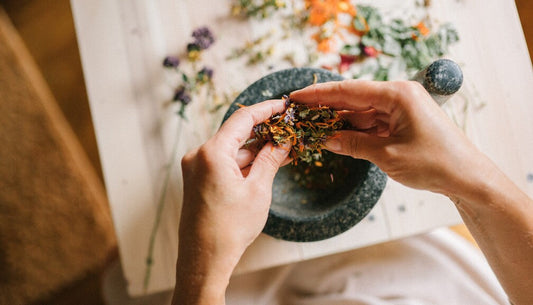If you live in the Northern Hemisphere, the time change in the fall can throw off your healthy schedule, leaving you tired and blue. Barbecues and fresh fruit snacks turn into pasta and potato meals. After-dinner walks or runs are replaced with time on the couch as darkness sets in. For many, late fall means driving to work in the dark and coming home to the same. It’s no wonder you feel out of sorts at the changing of the seasons.
You can, however, create balance with a few adjustments to your daily routine. While the seasonal routine can shift according to your dosha, Ayurveda considers daily routine, or the circadian rhythm, to be another important part of staying balanced. Here’s an overview of which doshas rule the times of the 24-hour clock.
Since morning time is a shift from Vata to Kapha, it’s important to harness the Vata energy around 6 a.m. and wake up at that time or a few minutes before. This is especially important to a Kapha person who will experience more sluggishness in Kapha season.
Getting outside during daylight hours may be even more important if you don’t normally see the sun because of work. If that’s the case, eat your meal at your desk and use your lunchtime to walk outdoors, even if you only make loops around the parking lot at the office.
Balance out heavier foods with lightly cooked vegetables. For Kapha and Pitta types, baking or roasting vegetables is ideal. Vata types should lightly sauté veggies in olive or sesame oil. Try filling at least 50 percent of your plate with vegetables first then add smaller portions of the other foods.
Combat the change-of-season blues and fend off unwanted weight gain by sleeping at the appropriate time. An Ayurvedic routine suggests going to sleep by 10:30 p.m., but if you’re up, make sure you avoid eating. Drink an herbal tea and try to fast at least three hours before bed. If you honor this rhythm, you’ll feel lighter in the morning and more apt to have the energy to wake up on time.
You can stimulate the body naturally with invigorating herbs such as …
You can, however, create balance with a few adjustments to your daily routine. While the seasonal routine can shift according to your dosha, Ayurveda considers daily routine, or the circadian rhythm, to be another important part of staying balanced. Here’s an overview of which doshas rule the times of the 24-hour clock.
- 2 to 6 a.m. Vata time
- 6 to 10 a.m. Kapha time
- 10 a.m. to 2 p.m. Pitta time
- 2 to 6 p.m. Vata time
- 6 to 10 p.m. Kapha time
- 10 p.m. to 2 a.m. Pitta time
Wake Up on Time
During this transition season, it starts to get darker every morning—the sun doesn’t rise until after 7 a.m. Before this change, it was easier to get up between 5:45 and 6 a.m. because it was light out. Now, you may just want to turn over and go back to sleep. Not to mention, it’s also getting colder. In the air, you’ll notice an increase of the Vata dosha, but Kapha is rising as well with the transition toward winter. Those of you more to the north may already be experiencing some Kapha-like weather, which is damp and cold.Since morning time is a shift from Vata to Kapha, it’s important to harness the Vata energy around 6 a.m. and wake up at that time or a few minutes before. This is especially important to a Kapha person who will experience more sluggishness in Kapha season.
Get Outside When the Sun Is Out
Many people suffer from Seasonal Affective Disorder (SAD). According to the Mayo Clinic, one way to treat SAD is with light therapy. Natural light seems to raise serotonin levels and boost your mood. And you know the sun is a natural source of vitamin D. Even if it’s cloudy, try getting out and going for a brisk walk every day after lunch or during the first Pitta time, between 10 a.m. and 2 p.m. when the sun is at its highest in the sky.Getting outside during daylight hours may be even more important if you don’t normally see the sun because of work. If that’s the case, eat your meal at your desk and use your lunchtime to walk outdoors, even if you only make loops around the parking lot at the office.
Don’t Forget Your Veggies
If you experience low energy, drowsiness, or fatigue, it may be because you’re eating differently in the transition to winter. As the cold sets in, I crave foods like mac and cheese, baked potatoes, and warm breads. While these foods in moderation can balance a Vata type, in excess, these heavier foods will cause an increase in the Kapha dosha, making anyone feel heavy and lazy.Balance out heavier foods with lightly cooked vegetables. For Kapha and Pitta types, baking or roasting vegetables is ideal. Vata types should lightly sauté veggies in olive or sesame oil. Try filling at least 50 percent of your plate with vegetables first then add smaller portions of the other foods.
Exercise Early in the Second Kapha Period
In the colder months people tend to be less active, so fitting exercise into your daily routine will get you moving, and help ward off feelings of lethargy. During the fall and winter, the best time to get exercise is at the beginning of the second Kapha period, between 6 and 7 p.m. Yoga helps to balance hormones and brain chemistry and can help you feel better all around. Take a yoga class or do a yoga DVD at home.Sleep, Don’t Munch, During the Second Pitta Time
Munching season starts around Halloween and ends sometime after Valentine’s Day. You might find yourself raiding the kids’ Halloween candy or stuffing yourself with Thanksgiving leftovers long after everyone is in bed. Did you know the second Pitta time of the day, between the hours of 10 p.m. and 2 a.m., are designed for detoxification and rejuvenation of the body? You may feel hungry but your digestive fire or Agni is designed to repair cells and make new ones at this time, not digest food.Combat the change-of-season blues and fend off unwanted weight gain by sleeping at the appropriate time. An Ayurvedic routine suggests going to sleep by 10:30 p.m., but if you’re up, make sure you avoid eating. Drink an herbal tea and try to fast at least three hours before bed. If you honor this rhythm, you’ll feel lighter in the morning and more apt to have the energy to wake up on time.
Stimulate Your Kapha
Kapha is the dosha that’s most prone to the dulling effects of the time change. Give your dosha a boost with Kapha-pacifying herbs, teas, and oils.You can stimulate the body naturally with invigorating herbs such as …
- Cloves
- Pepper
- Juniper
- Eucalyptus
- Ginger
- Drink 3 to 4 cups of Kapha tea each day
- Rub Kapha Abhy oil on your body, vigorously
- Burn incense or a Kapha-pacifying candle






















